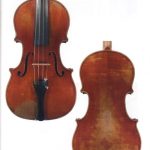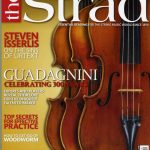The Strad magazine, July 2011 issue: In focus: Eugenio Praga
Copyright © 2011 Alberto Giordano – The Strad magazine. All rights reserved
Maker
Eugenio Praga was born on 17 April 1847 in Casale Monferrato, in what was then the Kingdom of Sardinia. Unlike most 19th-century italian violin makers, he was not from a humble background: his father, Pietro, was a well-known and wealthy engineer, and before dedicating himself to violin making, the young Eugenio took a degree in engineering at the University of Florence. It seems unusual that a man of such a high social standing should become a violin maker in the Italy of that period, and it is not known
why he decided to dedicate himself to lutherie.
Records and documents trelating to Praga’a life are scarce. The best source of information about him is a collection of letters left by NIcolò Bianchi, the violin maker who emplyed him in Genoa around 1969. Praga worked alongside Bianchi until 1878, when the old maker moved to Nice, leaving his workshop to his young pupil. During this initial period, Praga’s output was greatly influenced by Bianchi’s later style – the instruments are mostly unantiqued and coated with a thick, red varnish. During the 1880s Praga’s style shifted towards classical Italian violin making, and started making good copies of Stradivari and Guarneri instruments. The turning point in his career came when he began examining the ‘Cannone’ Guarneri ‘del Gesù’, which was preserved in Genoa’s town hall. His study of this instrument led Praga to create a serie of violins from the late 1880s that show inspiration, good taste and an interesting balance between antiqued and unantiqued work.
Praga made fewer than one hundred instruments, including violins, violas, a few cello and a double bass, but the quality is always remarkable. There is no evidence of him having pupils, but it seems likely that he occasionally relied on the collaboration of Enrico Rocca, since there are many similarities in their techniques and in the models they used – Rocca’s touch is especially apparent in Praga’s cellos.
Praga died on August 28th 1901.
Instrument
The interior of this violin was made using an internal mould with slanted centre corner slots. The blocks and lining are made of spruce with well-rounded linings set simply to the corner blocks. The front arching is reminiscent of the flatty curved arching of the ‘Cannone’, and the back is more rounded and hollow in the C-bouts.
The purfling is made of ebony and maple. The white portion is slightly thicker than the black, and both were made in single pieces for the upper and lower bouts: knife marks from the channelling action are visible along the borders.
The f-holes are taken from the ‘Cannone’, although Praga intentionally reduces the asymmetry in the drawing and the placement. The platters are gently fluted and the upper holes slightly ovalized. The head show Praga’s skill in interpreting the craftsmanship of the ‘Cannone’. He successfully reproduced the contour of the scroll, and never exaggerated Guarneri’s strong lines. As a result it is neither too broad, nor too heavy, as is the case with many other maker’s copies of ‘del Gesù’ instrument. Praga’s interpretation smoothes Guarneri’s wild cuts in order to achieve a personal balance – he respectfully avoids making a mere reproduction of the original violin.
Measurements in mm:
- Back length – 355.5
- Upper length – 168
- Middle length – 109
- Lower length – 204
- Body stop – 197





